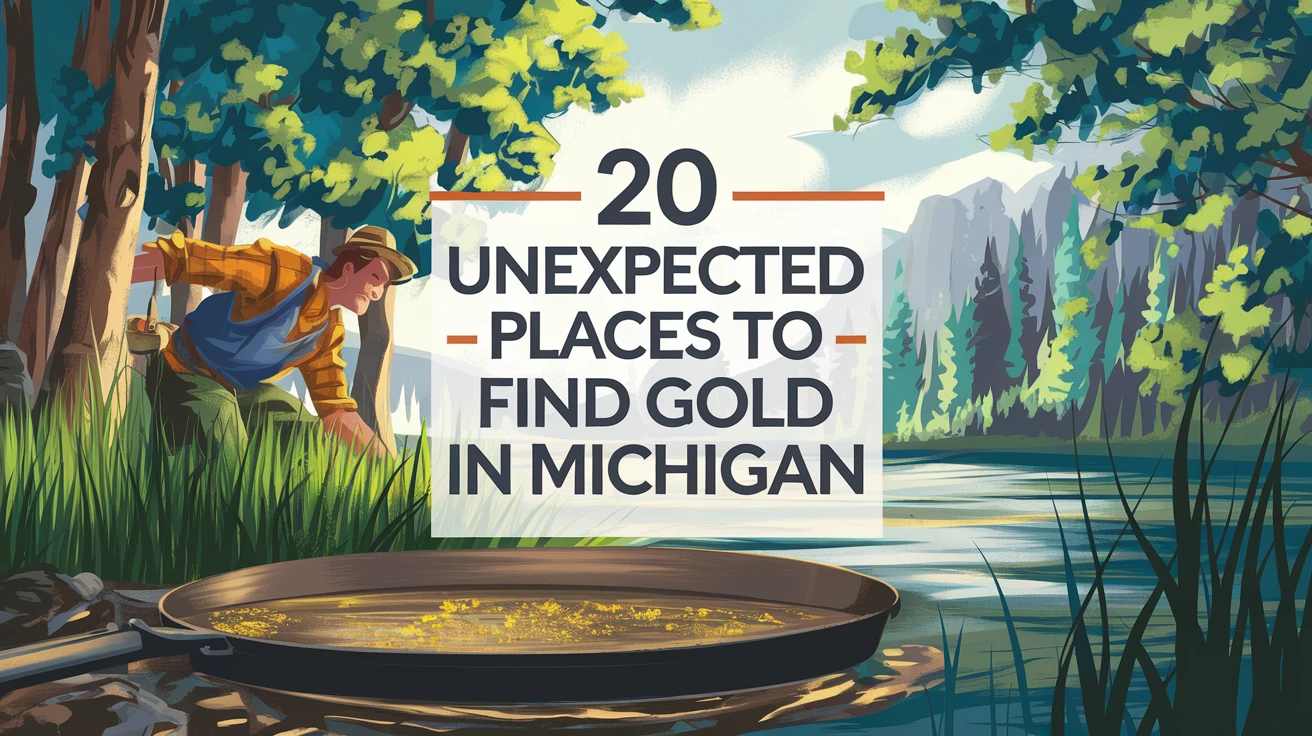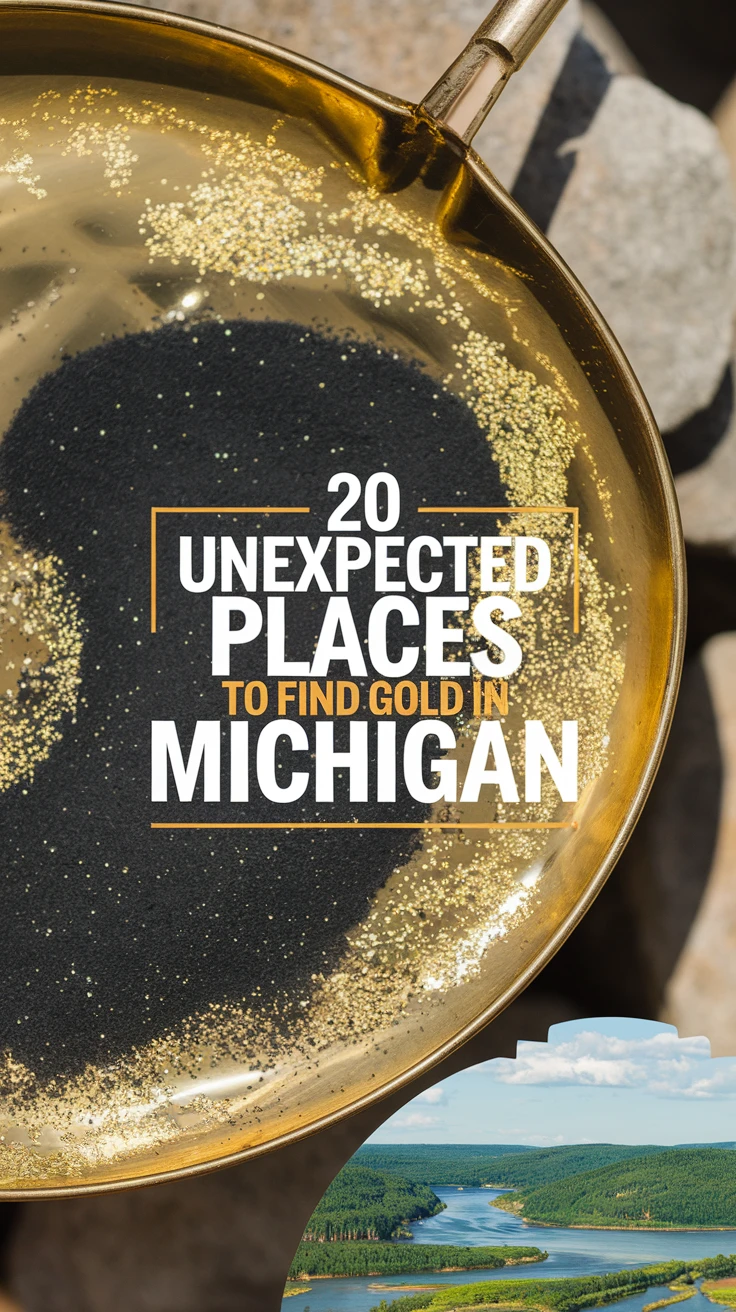
When most people think of gold panning, their minds drift to California’s historic Gold Rush or the rugged streams of Alaska. However, hidden within Michigan’s diverse landscape lies a treasure trove of opportunities for prospecting enthusiasts. From the crystal-clear waters of the Upper Peninsula to the unexpected creeks of the Lower Peninsula, Michigan offers numerous locations where amateur prospectors can try their luck at striking gold. While you might not get rich quick, the thrill of discovering even a small gold flake makes the adventure worthwhile. Let’s explore 20 surprising locations where you can pan for gold in the Great Lakes State.
Understanding Michigan’s Gold History
Michigan’s gold-bearing history dates back to the late 1800s when the first documented gold discoveries were made. While never experiencing a full-scale gold rush, the state has consistently yielded small but meaningful amounts of placer gold, particularly in glacial deposits.
Historical Gold Production
| Time Period | Major Discoveries | Location |
|---|---|---|
| 1880s | First Documented Find | Marquette County |
| 1890s | Ropes Gold Mine | Ishpeming |
| 1920s | Peninsula Mining Boom | Upper Peninsula |
| Present Day | Recreational Panning | Statewide |
Upper Peninsula Gold Hotspots (Locations 1-10)
1. Ropes Gold Mine Area
Located near Ishpeming, this historic site offers promising prospects in nearby streams. The abandoned mine area contains gold-bearing quartz veins, making the surrounding waterways prime locations for placer gold.
2. Dead River Basin
This extensive watershed near Marquette has yielded numerous gold finds. Focus on areas below the old dam structures where heavy minerals naturally concentrate.
3. Silver Lake Basin
Despite its name, this location near Marquette has produced both silver and gold. Look for black sand deposits, which often indicate the presence of gold.
4. Menominee River
The river’s bends and rapids create natural gold traps. Best results are found after spring thaws when fresh material has been exposed.
5. Tahquamenon River
While famous for its falls, the river’s upper reaches contain glacial deposits where fine gold can be found.
6. Carp River
Located in Marquette County, focus on areas where the water slows and creates natural settling pools.
7. Yellow Dog River
This remote location requires some hiking but offers undisturbed prospecting opportunities.
8. Sturgeon River
Gold has been found in both the main channel and tributaries. Look for areas with exposed bedrock.
9. Paint River
The river’s meandering course through Iron County creates numerous gold-catching locations.
10. Chocolay River
Focus on the sections near ancient glacial moraines for better chances of success.
Lower Peninsula Hidden Treasures (Locations 11-20)
Essential Equipment for Each Location
| Location Type | Required Equipment | Optional Tools |
|---|---|---|
| Rivers | Pan, Classifier, Shovel | Sluice Box |
| Creeks | Hand Pan, Trowel | Snuffer Bottle |
| Glacial Deposits | Dry Washer, Screen | Metal Detector |
| Beach Areas | Fine Screen Pan | Beach Scoop |
11. Grand River Gravel Bars
Particularly promising after high water events, focus on inside bends where gold naturally settles.
12. Muskegon River System
Check areas downstream from old glacial moraines where gold-bearing material has accumulated over millennia.
13. Au Sable River Banks
The name literally means “of sand” in French, and its sandy banks occasionally yield fine gold.
14. Manistee River Deposits
Focus on areas where the river cuts through glacial deposits, especially after spring thaws.
15. Black River Gold Zones
While less known, this river has produced consistent, albeit small, gold findings.
16. Pere Marquette River
Check gravel bars and inside bends, particularly after seasonal flooding.
17. Thunder Bay River
Focus on areas where the river slows and creates natural settling pools.
18. Flat River Prospects
Historical mining in the area suggests potential for recreational prospectors.
19. Looking Glass River
Small but consistent findings have been reported in specific bends.
20. Red Cedar River
University studies have confirmed the presence of placer gold in select locations.
Essential Tips and Legal Considerations
Seasonal Prospecting Guide
– Spring: Best after thaws expose new material
– Summer: Ideal for shallow water prospecting
– Fall: Lower water levels reveal new areas
– Winter: Focus on dry washing techniques
Legal Requirements
– Obtain necessary permits from DNR
– Respect private property boundaries
– Follow environmental regulations
– Report significant findings
Safety Considerations
– Never prospect alone
– Carry basic first aid supplies
– Check weather conditions
– Bring adequate water and supplies
Conclusion
While Michigan may not rival the famous gold fields of the western United States, its diverse geological history has created numerous opportunities for recreational prospectors. Success in Michigan gold panning requires patience, proper technique, and knowledge of productive locations. Whether you’re a seasoned prospector or just starting, these 20 locations offer exciting possibilities for finding gold in the Great Lakes State. Remember to always follow local regulations, respect private property, and practice environmental stewardship while pursuing your golden adventures.
Key Takeaways
- Michigan’s gold deposits are primarily found in glacial deposits and ancient river systems
- The Upper Peninsula generally offers better prospects than the Lower Peninsula
- Proper equipment and technique are crucial for success
- Always obtain necessary permits and follow local regulations
- Best results often come after spring thaws or significant rainfall events
Frequently Asked Questions
Do I need a permit to pan for gold in Michigan?
Yes, you typically need a recreational mining permit from the Michigan Department of Natural Resources for most locations.
What’s the best time of year to pan for gold in Michigan?
Late spring through early fall offers the best conditions, with spring being particularly productive after the thaw.
What basic equipment do I need to start gold panning in Michigan?
Essential equipment includes a gold pan, classifier, shovel, and snuffer bottle. Rubber boots and weather-appropriate clothing are also important.
Can I keep the gold I find?
Yes, recreational prospectors can keep their finds, but commercial mining requires additional permits and licenses.
How much gold can I expect to find?
Most finds are small flakes and occasional small nuggets. Expect results measured in grains rather than ounces.
Are there any restricted areas for gold panning?
Yes, some state parks and private properties are off-limits. Always verify land ownership and access rights before prospecting.
What’s the largest gold nugget ever found in Michigan?
The largest documented gold nugget found in Michigan weighed approximately 1.07 ounces, discovered in the Upper Peninsula.
Can I use a metal detector for gold prospecting?
Yes, metal detecting is allowed in many areas, but specific permits may be required, and some locations restrict this activity.
What geological indicators suggest the presence of gold?
Look for black sand, quartz veins, and areas where water flow naturally slows and creates deposits.
How deep should I dig when panning?
Focus on the layer just above bedrock, typically within the first 1-3 feet of material in productive areas.

